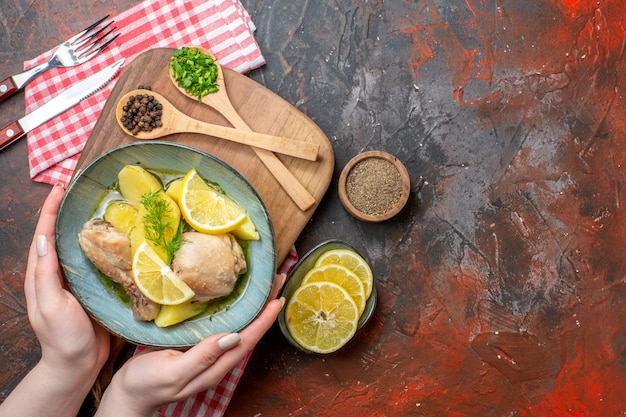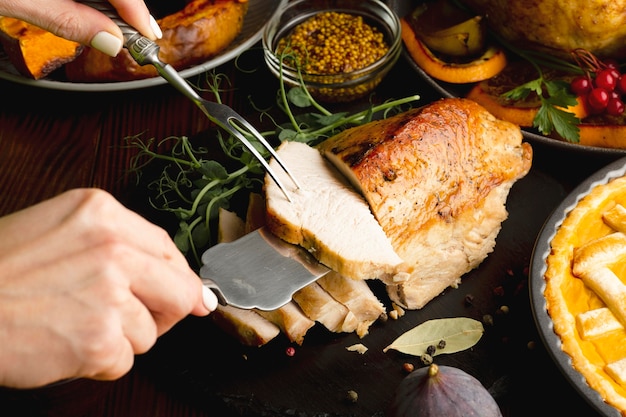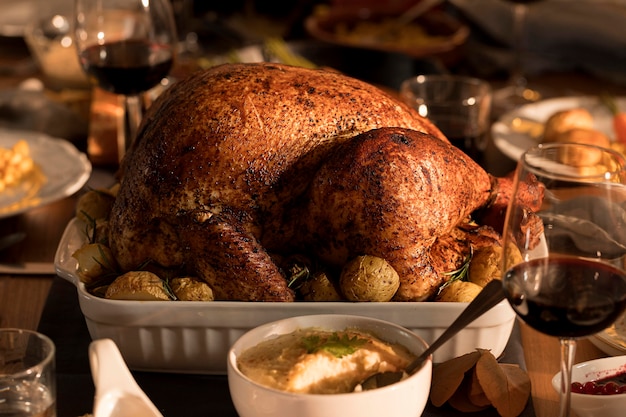Christmas is just around the corner, and you know what that means? Turkey time! Now, I'm not going to lie, cooking a turkey can be a bit daunting, especially if you're not a seasoned chef. But don't worry, I'm here to guide you through the whole process, from prepping to carving, and everything in between. Trust me, with this step-by-step guide, you'll be serving up a delicious and impressive turkey that'll have everyone singing your praises. Let's get started, shall we?
Part 1: Choosing the perfect turkey

First things first, you need to pick the right turkey. You've got a couple of options: fresh or frozen. Personally, I always go for fresh, but frozen is perfectly fine too – just make sure you give it enough time to thaw properly. And while we're on the topic, let's talk about size. You want to choose a turkey that's big enough to feed everyone, but not so big that you're left with mountains of leftovers. A good rule of thumb is to allow about 1 pound per person, but if you've got a bunch of big eaters, you might want to bump that up a bit.
Choosing the Right Size
So, how do you actually figure out the right size? Most turkeys come labelled with their weight. You can also find a handy guide on the Butterball website that tells you how many people each size will serve. Just pop it into your browser and you'll be sorted.
Fresh or Frozen?
As I said, fresh turkeys are my go-to. They have a bit more flavour, and you can skip the whole thawing process. But if you're planning on making your turkey a few days in advance, then frozen is the way to go. Just make sure you follow the thawing instructions carefully.
To safely thaw a frozen turkey, you have a few options:
- Refrigerator thawing: This is the safest method. Place the turkey in a container in the refrigerator and allow at least 24 hours for every 5 pounds of turkey to thaw.
- Cold water thawing: Submerge the turkey in a container of cold water, ensuring the water is constantly changing. Allow 30 minutes per pound to thaw.
- Microwave thawing: Some microwaves have a defrost setting, but this method is not recommended for whole turkeys due to uneven thawing and potential for undercooked areas.
Don’t Forget the Stuffing!
Oh, and another thing – if you're planning on stuffing your turkey, remember that it needs to be cooked separately. Trust me on this one, safety first, always! I'll go into more detail about stuffing later on.
Part 2: Prepping the Turkey

Now that you've got your turkey, it's time to prep it for cooking. Don't worry, this part is actually pretty simple.
Rinse and Dry
First, give your turkey a good rinse under cold water. Make sure you pat it dry with paper towels, otherwise, you'll end up with a soggy bird. This step is important for both fresh and thawed turkeys. The cold water helps to remove any bacteria from the surface of the bird.
Remove the Giblets
Next, you'll need to remove the giblets – those little packages of organs tucked inside the turkey cavity. Don't worry, they're not gross, they're actually quite delicious. You can use them to make a tasty broth or gravy later on. Just chuck them in a freezer bag and pop them in the freezer. If you're using a Butterball turkey, they usually come with a separate packet containing giblets, neck, and sometimes even wings.
Seasoning Time!
Now it's time to get creative and season your turkey. This is where you can really add your own personal touch. I like to use a simple blend of salt, pepper, and herbs, but you can go wild with different spices and seasonings. Just remember to be generous!
Here are some seasoning ideas for your turkey:
- Classic Herb Blend: Rosemary, thyme, sage, and garlic powder
- Citrusy Twist: Lemon zest, orange zest, and a touch of cayenne pepper
- Spicy Kick: Paprika, chili powder, cumin, and garlic powder
- Sweet and Savory: Brown sugar, smoked paprika, and a touch of cinnamon
No matter what seasoning you choose, make sure to rub it all over the turkey, both inside and out. Be sure to get it into the skin as well for maximum flavour.
Part 3: Getting Ready to Roast

Alright, your turkey is prepped and ready to go. Now, it's time to get your oven and roasting pan prepped.
Preheat the Oven
Firstly, crank up your oven to 325°F (165°C). Let it heat up nice and good. And while you're at it, get your roasting pan ready. You'll want to use a pan that's big enough to fit your turkey comfortably.
Get the Pan Ready
Now, for the roasting pan, I always use a little bit of oil to prevent sticking. Just rub a thin layer of oil around the bottom of the pan. You can use any type of oil, but I prefer to use olive oil because it has a nice flavour.
The Turkey Stand
If you've got a turkey stand, now's the time to use it. This will help the heat circulate evenly around the bird and make sure it cooks evenly. If you don't have a turkey stand, you can simply place the turkey on a bed of chopped vegetables in the roasting pan. This will help to keep the turkey from sticking to the pan and will also add flavour to the drippings.
Part 4: The Big Roast
Time to pop your turkey into the oven! It's the moment you've been waiting for. But before you do, let me give you a few tips to ensure a perfect roast.
Don’t Overcrowd
Make sure your turkey is the only thing in the oven. You don't want it to be crowded by other dishes, or it won't cook properly. And definitely no other dishes! It's a solo act in the oven for this little fellow.
Roast Time
Now, for the roasting time, you'll need to refer to the Butterball guide or the packaging of your turkey. The time will vary depending on the size of the bird. As a general rule, you should roast a turkey for about 13 minutes per pound if it's stuffed. If you're not stuffing your turkey, you can reduce the cooking time by 2-3 minutes per pound.
The First Hour
For the first hour, you'll want to roast the turkey uncovered. This helps the skin to crisp up nicely. It's important to get the skin nice and brown, as this will give your turkey a beautiful golden hue and help to seal in the flavour.
The Rest of the Roast
After the first hour, you can cover the turkey with some foil. This will help to keep it moist and prevent it from drying out. If you're adding stuffing, you'll want to uncover the turkey for the last hour to allow the stuffing to brown.
Keep it Moist
Every 30 minutes or so, you can baste the turkey with pan drippings or chicken stock. This will help to keep it moist and juicy. But, make sure you baste it with a spoon, not a brush. Don't use any brushes as it might introduce harmful bacteria. The drippings from the turkey are packed with flavour, so basting with them will help to give your turkey a delicious, savoury taste.
You can also use a roasting bag to help keep your turkey moist. However, if you want crispy skin, you'll need to roast the turkey uncovered.
Part 5: Checking for Doneness
So, how do you know when your turkey is cooked through? Well, the best way is to use a meat thermometer.
The Meat Thermometer
Insert the thermometer into the thickest part of the thigh, making sure it doesn't touch any bone. You want the internal temperature to reach 165°F (74°C). This ensures that the turkey is cooked to a safe temperature and prevents any risk of food poisoning.
Other Doneness Clues
Now, if you don't have a meat thermometer, there are a few other signs to look out for. The juices should run clear when you pierce the thigh, and the skin should be golden brown. However, these methods are not as reliable as using a meat thermometer, so I strongly recommend using one to ensure your turkey is cooked properly.
Part 6: Resting Time
Once your turkey is cooked, you'll need to let it rest for at least 15 minutes before carving. This allows the juices to redistribute throughout the bird, resulting in a juicier and more flavorful turkey. I know it's tempting to dig in right away, but trust me, it's worth the wait! It's important to let the turkey rest because it allows the juices to reabsorb into the meat, making it more tender and flavorful. This process also helps to ensure that the meat is cooked evenly throughout.
Part 7: Carving the Turkey
Right, your turkey is rested and ready to be carved. Here's how to do it like a pro:
Gather Your Tools
Grab a sharp carving knife and a carving fork. You'll also need a cutting board and a serving platter. A good carving knife will be sharp and have a long, thin blade. This will help you to make clean cuts and avoid tearing the meat. The carving fork will help you to hold the turkey steady while you carve it.
Remove the Legs and Thighs
Start by removing the legs and thighs. Cut through the joint between the leg and the body, then cut the thigh away from the leg. You can then separate the thigh and drumstick at the joint. You can also carve the thighs and drumsticks into smaller pieces for easier serving.
Slice the Breast
Next, slice the breast meat. You can cut it into thin slices, or you can leave it whole and carve it at the table. To slice the breast meat, hold the turkey firmly with the carving fork and use the knife to make thin, even slices. If you are carving the breast whole, you can remove the bones before carving or leave them in place, depending on your preference.
Don’t Forget the Wings
Finally, remove the wings and serve them alongside the turkey. You can also carve the wings into smaller pieces, or leave them whole. The wings are often considered to be a delicacy and are a good source of flavour.
Part 8: Serving Up the Feast
And there you have it! Your turkey is carved and ready to be served. I always like to arrange the turkey meat on a platter with some roasted vegetables and a generous helping of gravy.
Get the Sides Ready
Now, while your turkey is resting, it's a good time to get your side dishes ready. I always serve mashed potatoes, stuffing, and cranberry sauce. But feel free to get creative and add your own favourite side dishes. You can also make a variety of other side dishes, such as:
- Roasted Vegetables: Brussels sprouts, asparagus, carrots, and sweet potatoes.
- green bean casserole: A classic Thanksgiving dish, but you can make it even better by using fresh green beans.
- Cornbread Stuffing: A delicious and moist stuffing that pairs perfectly with turkey.
- Dinner Rolls: Serve with butter or honey for a delicious and comforting side.
The Gravy
And don't forget the gravy! You can make it from the pan drippings, or you can use a gravy mix. I prefer to make it from scratch, it just tastes so much better. And you can even add some of the giblets to the gravy for extra flavour. To make gravy from pan drippings, simply strain the drippings into a saucepan and whisk in some flour, butter, and stock. You can also add herbs and spices to your gravy for extra flavour.
Part 9: Leftover Love
Now, let's be real, there's always going to be some leftover turkey. And that's a good thing! Leftovers are an opportunity to get creative and make delicious meals.
turkey sandwiches
Of course, turkey sandwiches are always a classic. Just add some mayonnaise, lettuce, and tomato on a toasted bread. Yum! You can also add other ingredients to your turkey sandwich, such as cheese, avocado, or bacon.
turkey soup
You can also use leftover turkey to make a hearty and flavorful soup. Just add some vegetables, broth, and a little bit of pasta. You can use any type of vegetables for your turkey soup, but I like to use carrots, celery, and onions. You can also add some herbs and spices, such as thyme, bay leaf, or rosemary.
turkey pot pie
Or, you can make a delicious turkey pot pie. Just add some leftover turkey, gravy, and vegetables to a pastry crust and bake until golden brown. You can also use leftover stuffing in your turkey pot pie. Just add it to the filling along with the other ingredients.
turkey salad
A lighter option for leftover turkey is a delicious turkey salad. Combine leftover turkey, mayonnaise, celery, onion, and your favorite seasonings and serve it on bread, crackers, or lettuce wraps.
FAQs
1. How long does it take to cook a turkey?
The cooking time for a turkey will depend on its size. However, as a general guideline, allow for about 13 minutes per pound for a turkey stuffed with bread-based stuffing. If you are using a stuffing that is not bread-based, you can reduce the cooking time by 2-3 minutes per pound.
2. What should I do if my turkey is overcooked?
While it is best to avoid overcooking a turkey, if it does happen, don't worry! It won't be unsafe to eat. The meat might be a little dry, but it will still be edible. It is always a good idea to use a meat thermometer to ensure that your turkey is cooked through. If your turkey is overcooked, you can try to make it more moist by serving it with gravy or sauce. You can also shred the meat and use it in other dishes, such as soups or salads.
3. What is the best way to store leftover turkey?
You should store leftover turkey in an airtight container in the refrigerator. It will keep for 3-4 days. You can also freeze leftover turkey for up to 2 months. When freezing, make sure to wrap it tightly in freezer-safe plastic wrap or aluminum foil. To thaw frozen turkey, you can place it in the refrigerator for 24 hours per 5 pounds of turkey. You can also thaw it in cold water, but make sure to change the water every 30 minutes.
4. Can I use a turkey roasting bag?
You can certainly use a turkey roasting bag! It will help to keep the turkey moist and tender. However, it will prevent the skin from crisping up. If you want crispy skin, it's best to roast the turkey uncovered. Turkey roasting bags are a great option if you want a more moist turkey, but they can also make it more difficult to achieve crispy skin. If you're using a roasting bag, make sure to follow the manufacturer's instructions carefully.
5. How do I clean my roasting pan?
Cleaning a roasting pan after cooking a turkey can be a bit of a challenge. But, it’s not too tricky. First, let the pan cool completely. Then, fill it with hot water and a few tablespoons of dish soap. Let it soak for a few minutes. Next, scrub the pan with a sponge or a brush. If the pan is still greasy, you can use a little bit of baking soda. Rinse the pan with hot water, and dry it with a clean cloth. And if you’ve used a roasting bag, you can simply discard it after use.
And that’s it, folks! You’ve got your ultimate step-by-step guide to cooking the perfect turkey. With a little bit of planning and preparation, you’ll be serving up a delicious and impressive turkey that will impress even the most discerning guests. So, get in the kitchen, gather your ingredients, and let’s get cooking! Happy holidays!
Everyone is watching

How to Cook Frozen Lobster Tails Perfectly: A Step-by-Step Guide
RecipesLobster. Just the word conjures up images of lavish meals, special occasions, and a taste of luxury. But let's...

Pigs in a Blanket Cooking Time: How Long to Bake for Perfect Results
RecipesAh, pigs in a blanket. Just the name conjures up images of those delightful little parcels of crispy pastry en...

Pork Fillet Cooking Time: How Long to Cook It Perfectly
RecipesPork fillet, or tenderloin as it's sometimes called, is a real favourite in our house. It's so versatile, and...

The Ultimate Guide to Tender, Juicy Pulled Pork
RecipesRight, let's talk pulled pork. It's one of those dishes that just screams "comfort food," doesn't it? I mean...

The Ultimate Guide to Cooking Sweet Potatoes: From Roasting to Mashing
RecipesSweet potatoes. Just the name conjures up images of warm, comforting dishes, bursts of vibrant color, and a to...
